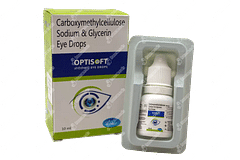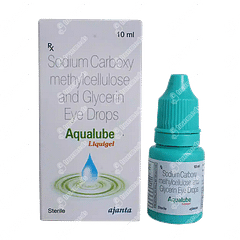Carboxy Methyl Cellulose + Glycerin + Oxychloro Complex
Uses of Carboxy Methyl Cellulose + Glycerin + Oxychloro Complex
The primary use of the combination of Carboxy Methyl Cellulose + Glycerin + Oxychloro Complex is to manage the symptoms of dry eye syndrome. This combination belongs to the group of ophthalmic medications used for eye lubrication.
Side effects of Carboxy Methyl Cellulose + Glycerin + Oxychloro Complex
Temporary blurred vision
Eye irritation
Mild burning sensation
Brief stinging sensation
Slight redness of eyes
How Carboxy Methyl Cellulose + Glycerin + Oxychloro Complex works
Carboxy Methyl Cellulose + Glycerin + Oxychloro Complex is an ophthalmic lubricant and preservative combination.
Carboxy Methyl Cellulose is a derivative of cellulose which acts like the mucus layer of our natural tears. It adheres to the surface of the eye, lubricating it and keeping it moist for longer periods.
Glycerin is a type of humectant, a substance that attracts and holds onto water like a sponge. It pulls in moisture from the air to keep the surface of the eye hydrated.
Oxychloro Complex serves as an antimicrobial preservative. It ensures that the solution remains sterile and free from harmful bacteria or fungi that might contaminate it.
Certified content
Written By

BDS, MDS
Reviewed By

BMS, FMC, MD Resident
Expert Advice
Dosage Forms Available
Carboxy Methyl Cellulose + Glycerin + Oxychloro Complex is available for use via the ophthalmic route in the form of a sterile solution or gel.
These ophthalmic products come in both multi-dose bottles and single-use vials, suitable for administering directly into the eyes.
Age and Dose Restrictions
This medicine is meant for use by adults and children. However, specific age restrictions may apply based on individual products. It is advisable to consult a doctor to confirm suitability for children.
Contraindications
Carboxy Methyl Cellulose + Glycerin + Oxychloro Complex is contraindicated in patients with known hypersensitivity to any of its ingredients.
It should also be avoided by individuals with severe dry eye conditions or those suffering from corneal abrasions or ulcers.
Other Medications to Avoid
Carboxy Methyl Cellulose + Glycerin + Oxychloro Complex may interact with ophthalmic antihistamines (such as ketotifen, olopatadine), beta-blocker eye drops (such as timolol, betaxolol), corticosteroid eye drops (such as prednisolone, dexamethasone), ophthalmic antibiotics (such as tobramycin, ciprofloxacin), nonsteroidal anti-inflammatory eye drops (such as ketorolac, diclofenac), and eye medications for glaucoma (such as latanoprost, bimatoprost).
Overdose and Missed Dose
In case you happen to put a few extra drops of Carboxy Methyl Cellulose + Glycerin + Oxychloro Complex in your eye, do not panic. Rinse your eyes with clean water at room temperature. If any symptoms persist or worsen, inform your doctor.
If you miss a dose of this medicine, administer it as soon as you remember. However, if it is almost time for your next scheduled dose, skip the missed dose and continue with your regular dosing schedule. Do not double the dose to catch up.
Management of Side Effects
Most side effects are temporary and generally harmless and resolve when discontinuing this medicine. However, if you experience any severe side effects or worsening of any of the symptoms, please consult your doctor.
If experiencing slight eye irritation or discomfort after application, try using the drops at a different time of day under different environmental conditions (e.g., less windy).
Staying hydrated can help alleviate any minor irritation caused by dryness.
Use in Driving and Operating Machinery
Vision may be temporarily blurred immediately after applying Carboxy Methyl Cellulose + Glycerin + Oxychloro Complex. It is advisable to avoid driving or operating heavy machinery until your vision has cleared and you are sure that your ability to perform these activities safely has not been compromised.
Use in Pregnancy and Lactation
Consultation with a doctor is advised before using this medicine during pregnancy or while breastfeeding.
Caution in Other Conditions
Patients with severe ocular conditions or those who have experienced recent eye surgery should exercise caution when using Carboxy Methyl Cellulose + Glycerin + Oxychloro Complex. The presence of certain eye conditions might require adjustment of treatment plans involving this medicine.
Special Dietary and Lifestyle Recommendations
For individuals suffering from dry eye syndrome, increasing omega-3 fatty acid intake through foods like fish or flaxseeds may help enhance natural tear production.
Maintaining good indoor air quality by avoiding smoke and using a humidifier during dry seasons can help manage symptoms associated with dry eyes.
Regular breaks from screen use can significantly reduce eye strain and discomfort associated with prolonged focus on digital devices.
Wearing sunglasses outdoors can protect against wind and sun exposure that may exacerbate dry eye symptoms.
Frequently asked questions
Is Carboxy Methyl Cellulose + Glycerin + Oxychloro Complex a steroid?
No, the combination is not a steroid. It comprises a lubricant, a moisturiser, and a preservative found in certain ophthalmic products.
How much time does Carboxy Methyl Cellulose + Glycerin + Oxychloro Complex take to show effect?
This combination starts working immediately upon administration. It aims to provide relief from dry eyes and related discomfort.
Does Carboxy Methyl Cellulose + Glycerin + Oxychloro Complex impact mood or hormonal balance?
No, this combination is an ophthalmic product and is not known to have any impact on mood or hormonal balance.
Is it safe to use Carboxy Methyl Cellulose + Glycerin + Oxychloro Complex every day?
Yes, it is safe to use this product daily as directed by your doctor for managing dry eye syndrome and related discomfort.
Are there any food restrictions while taking Carboxy Methyl Cellulose + Glycerin + Oxychloro Complex?
No specific food restrictions are associated with this medication. However, maintaining good hydration can aid in managing dry eyes syndrome.
Is there an alternative to Carboxy Methyl Cellulose + Glycerin + Oxychloro Complex for treating dry eyes?
There are several eye drops and gels available for managing dry eyes. Consult with your doctor for the most suitable option for your condition.
Can Carboxy Methyl Cellulose + Glycerin + Oxychloro Complex cause dependency or withdrawal symptoms?
No, this combination used for managing dry eyes does not cause dependency or withdrawal symptoms.
Carboxy Methyl Cellulose + Glycerin + Oxychloro Complex in other salts





Subscribe
Claim your complimentary health and fitness tips subscription and stay updated on our newest promotions.
Download Truemeds
Manage your health with ease Download Truemeds today!Get easy access to medicine refills, health information, and more. With our app, you'll never have to wait in line again. Download now and start taking control of your health.

Contact Us
Our customer representative team is available 7 days a week from 9 am - 9 pm.
v3.4.10
Our Payment Partners








